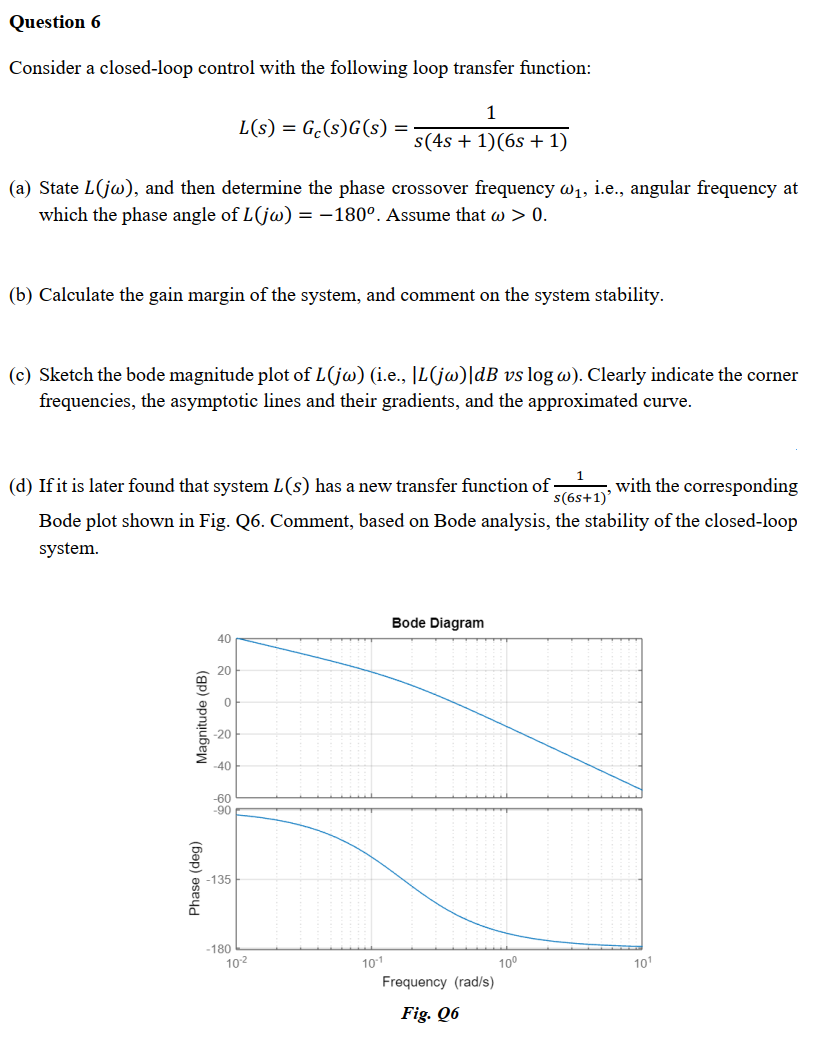Consider a closed-loop control with the following loop transfer function: 1 L(s) = Ge(s)G(s) = s(4s + 1)(6s + 1) (a) State L(jw), and then determine the phase crossover frequency w₁, i.e., angular frequency at which the phase angle of L(jw) = -180°. Assume that w > 0.
Consider a closed-loop control with the following loop transfer function: 1 L(s) = Ge(s)G(s) = s(4s + 1)(6s + 1) (a) State L(jw), and then determine the phase crossover frequency w₁, i.e., angular frequency at which the phase angle of L(jw) = -180°. Assume that w > 0.
Introductory Circuit Analysis (13th Edition)
13th Edition
ISBN:9780133923605
Author:Robert L. Boylestad
Publisher:Robert L. Boylestad
Chapter1: Introduction
Section: Chapter Questions
Problem 1P: Visit your local library (at school or home) and describe the extent to which it provides literature...
Related questions
Question
Q6 A only thank you

Transcribed Image Text:Question 6
Consider a closed-loop control with the following loop transfer function:
1
L(s) = Ge(s)G(s) =
s(4s + 1)(6s + 1)
(a) State L(jw), and then determine the phase crossover frequency @₁, i.e., angular frequency at
which the phase angle of L(jw) = -180°. Assume that w > 0.
(b) Calculate the gain margin of the system, and comment on the system stability.
(c) Sketch the bode magnitude plot of L(jw) (i.e., |L(jw)|dB vs log w). Clearly indicate the corner
frequencies, the asymptotic lines and their gradients, and the approximated curve.
with the corresponding
(d) If it is later found that system L(s) has a new transfer function of
s(6s+1)'
Bode plot shown in Fig. Q6. Comment, based on Bode analysis, the stability of the closed-loop
system.
Bode Diagram
40
20
0
Magnitude (dB)
Phase (deg)
-20
-40
-60
-90
-135
-180
10-²
10-1
Frequency (rad/s)
Fig. Q6
10⁰
10¹
Expert Solution
This question has been solved!
Explore an expertly crafted, step-by-step solution for a thorough understanding of key concepts.
Step by step
Solved in 2 steps with 1 images

Knowledge Booster
Learn more about
Need a deep-dive on the concept behind this application? Look no further. Learn more about this topic, electrical-engineering and related others by exploring similar questions and additional content below.Recommended textbooks for you

Introductory Circuit Analysis (13th Edition)
Electrical Engineering
ISBN:
9780133923605
Author:
Robert L. Boylestad
Publisher:
PEARSON

Delmar's Standard Textbook Of Electricity
Electrical Engineering
ISBN:
9781337900348
Author:
Stephen L. Herman
Publisher:
Cengage Learning

Programmable Logic Controllers
Electrical Engineering
ISBN:
9780073373843
Author:
Frank D. Petruzella
Publisher:
McGraw-Hill Education

Introductory Circuit Analysis (13th Edition)
Electrical Engineering
ISBN:
9780133923605
Author:
Robert L. Boylestad
Publisher:
PEARSON

Delmar's Standard Textbook Of Electricity
Electrical Engineering
ISBN:
9781337900348
Author:
Stephen L. Herman
Publisher:
Cengage Learning

Programmable Logic Controllers
Electrical Engineering
ISBN:
9780073373843
Author:
Frank D. Petruzella
Publisher:
McGraw-Hill Education

Fundamentals of Electric Circuits
Electrical Engineering
ISBN:
9780078028229
Author:
Charles K Alexander, Matthew Sadiku
Publisher:
McGraw-Hill Education

Electric Circuits. (11th Edition)
Electrical Engineering
ISBN:
9780134746968
Author:
James W. Nilsson, Susan Riedel
Publisher:
PEARSON

Engineering Electromagnetics
Electrical Engineering
ISBN:
9780078028151
Author:
Hayt, William H. (william Hart), Jr, BUCK, John A.
Publisher:
Mcgraw-hill Education,